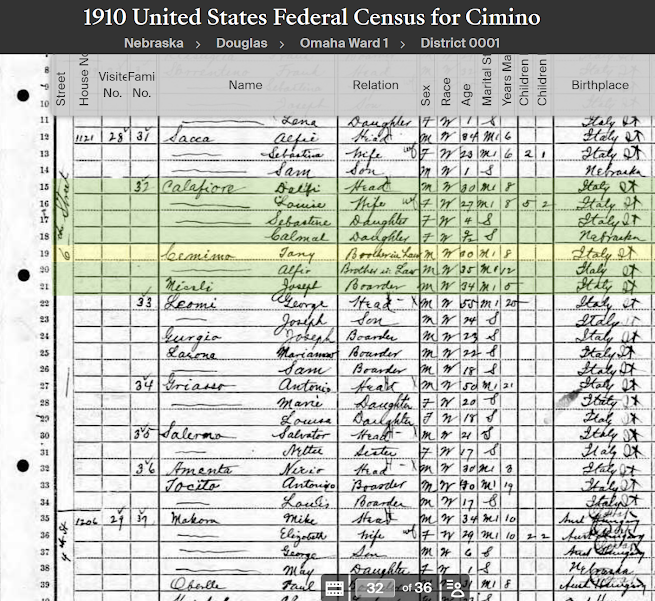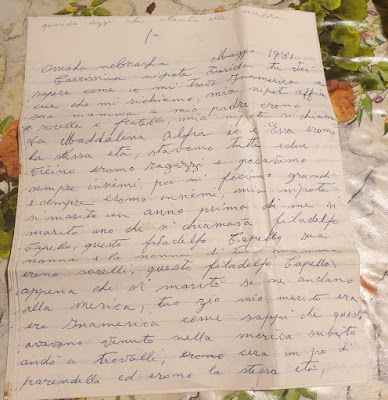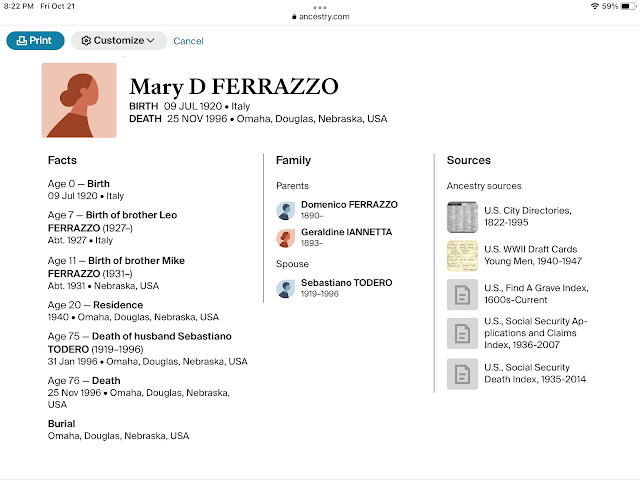As most of you know, I am a genealogist. When I research the birth and death records, I like to note the name of the street where the birth or the death occurred. If someone is planning a trip to Lentini or Carlentini, I recommend that they visit the street address where their ancestors were born or died. Sometimes, I have difficulty recognizing the names of the street in the old handwriting.
Here is a list of the streets of Lentini to help my research. Please review this list and let me know the names of any streets that I have missed. If you know the original names of the streets before they were changed to the current names, please let me know.
If you have any history or stories about these streets and the people that lived on them, please let me know.
TRANSLATION: Le strade di Lentini
Come molti di voi sanno, sono un genealogista. Quando cerco i documenti di nascita e di morte, mi piace annotare il nome della strada in cui è avvenuta la nascita o la morte. Se qualcuno sta programmando un viaggio a Lentini o Carlentini, gli consiglio di visitare l'indirizzo dove sono nati o morti i suoi antenati. A volte ho difficoltà a riconoscere i nomi delle strade nell'antica grafia.
Ecco un elenco delle strade di Lentini per aiutare la mia ricerca. Per favore controlla questo elenco e fammi sapere i nomi di tutte le strade che ho perso. Se conosci i nomi originali delle strade prima che venissero cambiati nei nomi attuali, faccelo sapere.
Se avete qualche storia o storie su queste strade e sulle persone che vivevano su di esse, fatemelo sapere.
LIST OF STREETS [ELENCO DI STRADE]
Cortile: [Courtyard Ronco in Carlentini]
Alassio, Aquila, Ausonia, Brà, Canova, Demma, Foligno, Melingi, Palma, Panezio, Pantelleria, Sondrio, Tribulato
Contrada: [Neighborhood in countryside]
Biviere, Burione, Canalotto, Carmito, Colle Roggio, Cretazzi, Gabelluzza, Iroldo, Leonello, Marchese Casabianca
Piazza: [Plaza]
Aldo Moro, Alemagna, Beneventano, Camillo Benso di Cavour, Cesare Battista, Dante, Duomo, Giovanni da Procida, Guglielmo Oberdan, Guido Rossa, Madonna del Castello, del Popolo, Raffaello, Regina Elena, Repubblica, Scienza e Lavoro, dei Sofisti, Umberto, Vittorio Veneto
Piazzale: [small plaza]
Cimitero, Michelangelo
Strada: [Street]
di Bonifica 12, Comunale 2, Comunale 4, Consortile 37, Galerno
Strada Provinciale: [Provincial Streets]
Biviere Scordi, Lentini Scordia, Lentini Valsavoia
Strada Statale: [State streets]
Ragusana, di Caltagirone
Vicolo: [Alley]
Monza, Muzio Scevola, Orazio Coclite, Panezio, Sparta, Tre Santi
Viale: [Avenue]
Libertà, Regione Siciliana, Riccardo da Lentini
Via: [Street]
4 Novembre, 5 Maggio, 20 Settembre,
A
Abruzzo, Acqui, Adda, Addis Abeba, Adigrat, Adua, Agatocle, Agatone, Giuseppe Agnello, Agnone, Agata, Agrigento, Conte Alaimo, Alba, Albano, Albert Sabin, Alcide de Gasperi, Alessandro Manzoni, Alessandro Volta, Vittorio Alfieri, Alfio Incontro, Alfio Sgalambro, Salvador Allende, Amalfi, Michele Amari, Amba Aradam, Ambrogio Donati, Amerigo Vespucci, Vito Amico, Anapo, Ancona, Andrea Costa, Angelino Nobile, Giorgio Amendola, Giovanni Amendola, Anna Kuliscioff, Antonello da Messina, Antonino lo Surdo, Antonio Gramsci, Antonio Pacinotti, Apuania, Archimede, Aragona, Arancio, Aretusa, Arezzo, Argenta, Arimondi, Ludovico Ariosto, Armando Diaz, Arrigo Morandi, Arrigo Testa, Asiago, Aspromonte, Attilio Regolo,
B
Balilla, Paolo Balsamo, Barcellona, Giovanni delle Bande Nere, Francesco Baracca, Bari, Barletta, Bassano, Pisano Baudo, Belvedere, Benedetto Croce, Berenice, Bernardino Telesio, Bertrand Arthur William Russell, San Biagio, Biviere, Nino Bixio, Bologna, Francesco Bonfiglio, Bosco Cappuccio, Domenico Bottone, Giovanni Bovio, Brennero, Brescia, Bricinna, Brindisi, Giordano Bruno,
C
Caduti per la Pace, Fratelli Cairoli, Calatafimi, Calcidesi, Caltanissetta, Calì, Camarina, Campania, Campobasso, Canonico Sferazzo, Padre Francesco Cantella, Cappellini, Pier Capponi, Cappuccini, Capri, Capua, Luigi Capuana, Caracciolo, Cardillo, Giosuè Carducci, Carlo Alberto, Carlo Arturo Jemolo, Carlo Levi, Carlo Pisacane, Carlo Rosselli, Carlo de Cristoforis, Carlo del Prete, Carlo lo Presti, Carmagnola, Salvatore Carnevale, Carnia, Carrubbazza, Carso, Caruso, Casale, Cascina, Caserta, Casmene, Castel Bricinna, Filadelfo Castro, Catania, Catanzaro, Madonna della Catena, Cattolica, Girolamo Li Causi, Ceccano, Cecina, Cefalù, Centuripe, Cerere, Cervia, Giulio Cesare, Cesare Terranova, Salvatore Ciancio, Ciccio Carrà Tringali, Cicerone, Francesco Cilea, Cirene, Cirino Paone, Ciro Menotti, Gaetano Mario Columba, Cristoforo Colombo, Como, della Concordia, Conegliano Veneto, Consiglio, Conte Alaimo, Coppola, Cortina d'Ampezzo, Cosentino, Cosenza, Giuseppe Crimi, Francesco Crispi, Carlo de Cristoforis, Cristoforo Colombo, Benedetto Croce, Santa Croce, Crocifisso, Cuneo, Curtatone, Madame Marie Curie,
D
Damiano Chiesa, Daniele Manin, Decano, Domenico Bottone, Ambrogio Donati, Gaetano Donizetti, Duca d'Aosta, Duca del Mare, Duca di Genova, Ducezio, Eleonora Duse,
E
Edmondo de Amicis, Luigi Einaudi, Elba, Eleonora Duse, Elio Vittorini, Vittorio Emanuele II, Vittorio Emanuele III, Vittorio Emanuele da Bormida, Enna, Enrico de Nicola, Enrico Fermi, Enrico Toti, Epicarmo, Eraclea, Ercole, Ermocrate, Erodico, Eschilo, Esculapio, Etnea, Ettore Marchiafava, Euclide, Eugenio Colombo, Eugenio Montale, Eugenio Pertini, Eugenio di Savoia, Euripide,
F
Faenza, Falconello, Fano, Favara, Tommaso Fazello, Federico di Svevia, Enrico Fermi, Ferrara, Filadelfo Castro, Filadelfo Mauro, Filiberto, Filippo Neri, Filippo Turati, Filisto, Fiume, Flavio Gioia, Focea, Fontana, Fontanella, Forlì, Formia, Francesco Baracca, Francesco Bonfiglio, Francesco Cilea, Francesco Crispi, Francesco Marino, Francesco Spina, Monsignor Francesco la Rosa, San Francesco d'Assisi, Francofonte, Sigmund Freud
G
Gaetano Donizetti, Gaetano Mario Columba, Gaetano Tringali, Galileo Galilei, Galliano, Mohandas Karamchand Gandhi, Matteo Gaudioso, Giuseppe Garibaldi, Gennaro di Macco, Flavio Gioia, Giacomo Leopardi, Giacomo Matteotti, Giacomo Puccini, Giardini, Giggia, Portella della Ginestra, Gioacchino Rossini, Vincenzo Gioberti, Giordano Bruno, Giorgio Amendola, Giorgio la Pira, Giosuè Carducci, Giotto, Giovanbattista Pergolesi, Giovanni Amendola, Giovanni Battista Grassi, Giovanni Boccaccio, Giovanni Bovio, Giovanni delle Bande Nere, Giovanni Malfitano, Giovanni Meli, Don Giovanni Minzoni, Giovanni Pascoli, Giovanni Prati, Giovanni Verga, Giovanni XXIII, Girolamo Li Causi, Giulio Cesare, Giuseppe Agnello, Giuseppe Crimi, Giuseppe Garibaldi, Giuseppe Giusti, Giuseppe Parini, Giuseppe Mazzini, Giuseppe Tartini, Giuseppe Ungaretti, Giuseppe Verdi, Giuseppe Giusti, Goffredo Mameli, Gondar, Mario Gori, Gorizia, San Marco di Gorizia, San Gottardo, Gradisca, Antonio Gramsci, Granatello, Guglielmo Giudice, Guglielmo Marconi
I
Iceta, Imola [Paolo Meli], Indipendenza, Ignazio Silone, Immacolata, Ippolito Nievo, Isonzo, Italia, Notaro Jacopo
J
Notaro Jacopo
K
Martin Luther King
L
Lago di Lentini, Lanfranco, Largo Monreale, Largo Sacile, Lecce, Legnano, Bonifica del Lago di Lentini, Lago di Lentini, Ospedale Civile di Lentini, Riccardo da Lentini, Stazione Lentini, Stazione Lentini Diramazione, San Leonardo, Giacomo Leopardi, Carlo Levi, Libertà, Martiri della Libertà, Licata, Lisia, Lombardia, Luigi Longo, Lorenzo Piazza, Loreto, San Luciano, Ludovico Ariosto, Luigi Cadorna, Luigi Capuana, Luigi Einaudi, Luigi Galvani, Luigi Longo, Luigi Pirandello, Luigi Rizzo, Luigi Settembrini, Don Luigi Sturzo, la Lumia,
M
Macallè, Gennaro di Macco, Macello, Macerata, Maci, Madame Marie Curie, Madonna della Catena, Magenta, 5 Maggio, Maggiore Pietro Toselli, Ugo la Malfa, Giovanni Malfitano, Malta, Goffredo Mameli, Maniago, Daniele Manin, Mantova, Niccolò Machiavelli, Alessandro Manzoni, Ettore Marchiafava, Marco Polo, San Marco di Gorizia, Guglielmo Marconi, Duca del Mare, Marengo, Marie Curie, Margellina, Francesco Marino, Mario Gori, Mario Rapisardi, Marsala, Martin Luther King, Martiri della Libertà, Martiri della Resistenza, Nino Martoglio, Massa, Pietro Mascagni, Massenzio, Piersanti Mattarella, Matteo Gaudioso, Giacomo Matteotti, Filadelfo Mauro, San Mauro, Giuseppe Mazzini, Megara, Giovanni Meli, Ciro Menotti, Mentana dal 21 A Scendere, Saverio Mercadante, Messina, Antonello da Messina, Michele Amari, Monte San Pietro Micca, Michele, Milano, Milazzo, Mincio, Minniti, Don Giovanni Minzonimi, Modica, Mohandas Karamchand Gandhi, Monastero, Moncenisio, Monfalcone, Largo Monreale, Monsignor Francesco la Rosa, Eugenio Montale, Monte Grappa, Monte Nero, Monte Sabatino, Monte San Michele, Monte Santo, Monti Iblei, Eugenio Montale, Vincenzo Monti, Monza, Arrigo Morandi, Filadelfo Mugnos, Murganzio, del Museo, Muzio Scevola,
N
Napoli, Naro, Nasso, Nazario Sauro, Nazionale, Pietro Nenni, Neofito, Filippo Neri, Giovanni delle Bande Nere, Monte Nero, Pier Luigi Nervi, Niccolini, Niccolò Machiavelli, Niccolò Paganini, Enrico de Nicola, Ippolito Nievo, Nino Bixio, Nino Martoglio, Nisida, Angelino Nobile, Notaro Jacopo, Noto, Val di Noto, Novara, 4 Novembre
O
Guglielmo Oberdan, Oglio, degli Oleandri, Olivieri, degli Operai, Orbetello, Ortigia, Ospedale Civile di Lentini, Ortensio Scammacca, Ortisei, Orvieto [Aspromonte], Otello, Otello Marilli
P
Pablo Picasso, della Pace, Caduti per la Pace, Pacini, Antonio Pacinotti, Padre Francesco Cantella, Padre G. di Stefano, Niccolò Paganini, Salvatore Paglialunga, Stazione Palagonia, Palermo, Palestrina, Cortile Palma, Palmiro Togliatti, Panezio, Cortile Pantelleria, Paolo Balsamo, Paolo Sarpi, San Paolo, Cirino Paone, Paradiso, Giuseppe Parini, Partigiani, Giovanni Pascoli, Paternò, Patti, Silvio Pellico, Pergola, Giovanbattista Pergolesi, Ernesto Pertini, Eugenio Pertini, Perugia, Pesaro, Piacenza, Piave, Lorenzo Piazza, Pablo Picasso, Pier Capponi, Pier Luigi Nervi, Pier Maria Rosso di San Secondo, Piero Maroncelli, Piersanti Mattarella, Pietro Colletta, Pietro Micca, Pietro Nenni, Maggiore Pietro Toselli, Pesaro, Piemonte, de Pinedo, Piombino, Giorgio la Pira, Luigi Pirandello, Pisa, Carlo Pisacane, Pisano Baudo, Piscitello, Pistoia, Pitagora, Pola, Polibio, Marco Polo, Pordenone, Porrazzeto dal 20, Porta Siracusana, Portella della Ginestra, Portici, Porto Empedocle, Potenza, Giovanni Prati, Carlo lo Presti, del Prete, Carlo del Prete, Principe Tommaso, dei Profughi, del Progresso, Proserpina, Giacomo Puccini, Puglia, Re di Puglia
R
Ragusa, Mario Rapisardi, Redenzione, Regione Siciliana, Martiri della Resistenza, Re di Puglia, Riccardo da Lentini, Riva, Luigi Rizzo, Rodi, Roma, Ronchi, Monsignor Francesco la Rosa, Carlo Rosselli, Gioacchino Rossini, Rosso di San Secondo,
S
Albert Sabin, Monte Sabotino, Largo Sacile, Salerno, Salita Pisano, Salvador Allende, Salvatore Carnevale, Salvatore Ciancio, Salvatore Paglialunga, Salvatore Quasimodo, Salvo d'Acquisto, San Biagio, San Gottardo, San Francesco d'Assisi, San Leonardo, San Luciano, San Marco di Gorizia, San Mauro, San Paolo, Rosso di San Secondo, de Sanctis, Sassari, Saturno, Nazario Sauro, Saverio Mercadante, Monte San Michele, Santa Tecla, Santapaola, Paolo Sarpi, Eugenio di Savoia, Girolamo Savonarola, Nazario Sauro, Scala, Ortensio Scammacca, Segesta, Seggio, Largo Quintino Sella, Selinunte, 20 Settembre, Luigi Settembrini, Sezze, Alfio Sgalambro, Francesco Sgalambro, Sicilia, Regione Siciliana, dei Siculi, Diodoro Siculo, Siena, Sigmund Freud, Ignazio Silone, Silvio Pellico, Porta Siracusana, Socrate, Sofocle, Solferino, Tito Speri, Francesco Spina, Stabilimento, dello Stadio, Stazione Lentini, Stazione Lentini Diramazione, Stazione Palagonia, Padre G. di Stefano, Stradivario, Don Luigi Sturzo, Antonino lo Surdo
T
Tagliaverga, Talete, Lago Tana, Tanaro, Giuseppe Tartini, Tarvisio, Torquato Tasso, Bernardino Telesio, Teocle, Teodosio, Termidoro, Termini, Arrigo Testa, Timavo, Tintoretto, Tito Speri, Tiziano, Palmiro Togliatti, Toledo, Tolmezzo, Tolmino, Tommaso Agni, Tommaso Campanella, Tommaso Fazello, Principe Tommaso, Torquato Tasso, Maggiore Pietro Toselli, Trapani, Trasimaco, Trento, Trevi, Tricolore, cortile Tribulato, Trieste, Trinacria, Ciccio Carrà Tringali, Gaetano Tringali, Santissima Trinità, Filippo Turati,
U
Udine, Ugo Foscolo, Ugo la Malfa, Piazza Umberto, Umbria, Giuseppe Ungaretti, Urbino, Ustica
V
Val di Mazara, Val di Noto, Varese, Vaste, Conegliano Veneto, Venezia, Ventimiglia, Vercelli, Giovanni Verdi, Giovanni Verga, Verona, Amerigo Vespucci, Vietri, Vincenzo Gioberti, Vincenzo Monti, Vincenzo Vella, Giuseppe Verdi, Vitaliano Brancati, Vito Amico, Vincenzo Gioberti, Vincenzo Monti, Vincenzo Vella, San Vito, Elio Vittorini, Vittorio Alfieri, Vittorio Bottego, Vittorio Emanuele II, Vittorio Emanuele III, Vittorio Emanuele da Bormida, Alessandro Volta, Volturno
COMMENTS [COMMENTI]:
Maria Rita Barretta: Manca Piazza Guido Rossa che però non ha numeri civici. È lo spiazzo dove sorgeva l’antico carcere di Lentini, demolito se non sbaglio a fine anni ‘70. Le vie attorno sono Via Cecina, Salita Pisano, Piazza Regina Elena, via Urbino.
Dirimpetto al carcere la salita conduceva alla chiesa di San Francesco di Paola, e proprio su questa salita i parenti dei carcerati si recavano per colloqui familiari… non autorizzati 😄. Mia nonna mi raccontava che carcerati e parenti comunicassero cantando da una parte all’altra della strada, proprio nel tentativo di evitare controlli.
Per quanto ne so, non ci sono stati cambiamenti nei nomi delle vie a Lentini, io vorrei che fossero cancellate le intitolazioni ai Savoia, ma pare sia di difficile realizzazione
TRANSLATION: Piazza Guido Rossa is missing but has no house numbers. It is the clearing where the ancient Lentini prison stood, demolished if I'm not mistaken at the end of the 1970s. The streets around are Via Cecina, Salita Pisano, Piazza Regina Elena, via Urbino.
Opposite the prison the slope led to the church of San Francesco di Paola, and it was up this slope that the relatives of the prisoners went for family meetings... unauthorized 😄. My grandmother told me that prisoners and relatives communicated by singing from one side of the street to the other, in an attempt to avoid checks.
As far as I know, there have been no changes in the names of the streets in Lentini, I would like the Savoy names to be cancelled, but it seems to be difficult to achieve
Rosaria Fazio: Credo che l’attuale via Orvieto in passato fosse ancora via Aspromonte perché ho trovato una cartolina di mio nonno soldato (durante la grande guerra) con questo indirizzo ma abitava nell’attuale via Orvieto.
TRANSLATION: I believe that the current via Orvieto in the past was still via Aspromonte because I found a postcard from my soldier grandfather (during the great war) with this address but he lived in the current via Orvieto.
Roberto Commendatore: Ne mancano tantissime... Consiglio di andare jn tipografia è comprare lo stradario ...edizione vecchia ...edizione aggiornata.... Le trovi tutte...b.serata...
TRANSLATION: There are so many missing...I recommend going to the print shop and buying the road book...old edition...updated edition....You can find them all...good.evening...
MANCA MEANS MISSING
Pamela Lentini: Manca cortile Foligno
Mary Fisicaro: Manca via Lisia, via Termidoro e via Santa Tecla. Manca CORTILE DEMMA
Alfio Salanitro: Manca via Panezio
Massimiliano Tomasello: Cortile demma
Salvna Santacroce: Manca via Cirene dove sono nata
Diego Mangiameli: Manca via Eraclea
Loredana Rodilosso: Mancano via Iceta, via Cicerone e via San Luciano
Donatella Astuto: piazza Guido Rossa, via Termini, cortile Tribulato
Cettina Giampapa: Manca Piazza Umberto e la via Rosso di San Secondo.
Massimo Tomasello: L' attuale via Imola si chiamava via Paolo Meli, a mia memoria ci abitavano le famiglie Zacco, Lanteri, Ossino, Di Giorgio, Tomasello, Bosco, Risuglia, Libertini, Piccione, nonché le tedesche e la Guardia di Finanza. Vi abitavano inoltre altre famiglie di cui non ricordo il cognome.
TRANSLATION: The current via Imola was called via Paolo Meli, in my memory the Zacco, Lanteri, Ossino, Di Giorgio, Tomasello, Bosco, Risuglia, Libertini, Piccione families lived there, as well as the Germans and the Guardia di Finanza. Other families whose surnames I don't remember also lived there.
Floriana Aletta: Manca cortile Canova
Salvo Castoro: Cortile Melingi
Antonio Oliva: Le consiglio di andare in Posta. I postini, al mattino, incasellano le buste e i pacchi a firma nel casellario e lì trova tutte le vie, anche quelle più sconosciute. Avranno sicuramente delle liste accurate e aggiornate. Complimenti per la sua indagine interessante e che apprezzo.
TRANSLATION: I advise you to go to the post office. In the morning, the postmen place the envelopes and signed parcels in the filing cabinet and find all the routes there, even the most unknown ones. They will definitely have accurate and up-to-date lists. Congratulations for your interesting investigation and which I appreciate.
Luca Micciche: Piazza dei sofisti non vedo
Peppe Trovato: Piazza del Popolo?
Insolera Vincenzo: Manca via Teocle
Maria Antico: Piazza Vittorio Veneto
Thanks to Marco Occhipinti for bringing this wonderful blog post to our attention concerning a letter of eviction to a man in Lentini named Giuseppe Papa, son of the late Gaetano. This was a registered letter sent on 24 May 1921 from the municipality of Palagonia (Catania) to the house of Mr. Papa at Cortile Panezio without a house number.
https://www.sfizidiposta.it/2020/04/14/ti-sfratto/
Grazie a Marco Occhipinti per aver portato alla nostra attenzione questo meraviglioso post sul blog riguardante una lettera di sfratto indirizzata ad un uomo di Lentini di nome Giuseppe Papa, figlio del defunto Gaetano. Si tratta di una lettera raccomandata spedita il 24 maggio 1921 dal comune di Palagonia (Catania) all'abitazione del signor Papa al Cortile Panezio senza numero civico.
Marco Occhipinti: Buongiorno, Cortile Panezio
Francesco Mugno: Via Silvio pellico con entrata vicolo panezio
OLD STREET NAMES NOT ON THIS LIST:
VIA
Alpini, Santa Maria La Cava
Please let me know if you have any additions to this list or stories about the people on these streets.
Per favore fatemi sapere se avete qualche aggiunta a questo elenco o storie sulle persone in queste strade.
PRINCIPAL SOURCE FOR STREET NAMES: TuttoCittà (tuttocitta.it)

























